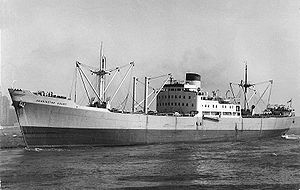SS Empire Brigade
 As the Hannington Court, prior to 1936 | |
| Career | |
|---|---|
| Name: |
Hannington Court (1912-36) Elios (1936-40) Empire Brigade (1940) |
| Owner: |
Court Line (1912-36) Achille Lauro (1936-40) Ministry of War Transport (1940) |
| Operator: |
Court Line (1912-36) Achille Lauro (1936-40) Cairns, Noble & Co Ltd, Newcastle-upon-Tyne (1940) |
| Port of registry: |
Template:Country data UKGBI London (1912-22) 22x20px Naples (1936-40) |
| Builder: | Sir John Priestman & Co Ltd, Southwick, Sunderland |
| Completed: | 1912 |
| Out of service: | 19 October 1940 |
| Identification: |
United Kingdom Official number 135157 (1912-36, 1940) Italian Official Number 462 (1936-40) Code letters JBDQ (1912-33) 30x15px30x15px30x15px30x15px Code Letters GRSZ (1934-36) 30x15px30x15px30x15px30x15px Code Letters IBFO (1936-40) 30x15px30x15px30x15px30x15px Code Letters GLZS (1940) 30x15px30x15px30x15px30x15px |
| Fate: | Torpedoed and sunk by U-99 |
| General characteristics | |
| Class and type: | Steam merchant ship |
| Tonnage: | 5,184 GRT |
| Length: | 400 feet (121.92 m) |
| Beam: | 53 feet 5 inches (16.28 m) |
| Depth: | 26 feet 6 inches (8.08 m) |
| Propulsion: | 1 x Blair & Co, Stockton triple expansion steam engine, 440 horsepower (330 kW) |
| Speed: | 10 knots (19 km/h) |
| Crew: | 41 |
Empire Brigade was a 5,184 GRT cargo ship which was built in 1912 as Hannington Court. She served through the First World War and was sold in 1936 to Achille Lauro, being renamed Elios. In 1940, she was interned by the United Kingdom as a result of war being declared against Italy. She was declared a war prize and taken into service by the Ministry of War Transport (MoWT) as Empire Brigade, serving until torpedoed and sunk by Template:GS.
Pre war career
Empire Brigade was built in the yards of Sir John Priestman & Co Ltd, Southwick, Sunderland as yard number 239. She was launched on 10 October 1902 and was completed in November 1912.[1] The ship was 400 feet (121.92 m) long, with a beam of 53 feet 5 inches (16.28 m) and a depth of 26 feet 6 inches (8.08 m). She was propelled by a triple expansion steam engine which had cylinders of 27 inches (69 cm), 44.5 inches (113 cm) and 74 inches (190 cm) bore by 48 inches (120 cm) stroke. The engine was made bu Blair & Co Ltd, Stockton on Tees.[2] It could propel the ship at 10 knots (19 km/h)[1]
She entered service as SS Hannington Court with Court Line and was allocated United Kingdom Official Number 135157 and Code Letters JBDQ.[2] In 1934, her Code Letters were changed to GRSZ.[3] Hannington Court served with them until 1936, when she was sold to the Italian shipping line owned by Achille Lauro and based in Naples. They renamed her Elios. Her Italian Official Number was 462 and she carried code letters IBFO.[4] She was in port in Newcastle when Italy entered the war, and she was consequently seized on 10 June 1940 by the Ministry of Shipping. They renamed her Empire Brigade and passed her to Cairns, Noble & Co Ltd, of Newcastle-upon-Tyne to operate for them. She was homeported in Newcastle upon Tyne. Her Official number reverted to 135157 and her code letters were GLZS.[5]
Wartime career and sinking
Empire Brigade took part in a number of local convoys, sailing to different ports in the UK.[citation needed] Her first international convoy came when she joined the ill-fated convoy SC-7. Empire Brigade sailed from Montreal to Sydney, Nova Scotia, Canada, from where the convoy sailed on 5 October 1940, bound for Leith via the Tyne. Empire Brigade carried a cargo of 750 tons of copper, 129 tons of ferrous alloys and 980 tons of steel, and as under the command of her master, Sydney Wyman Parks. The convoy had only a single escort to start with, the sloop HMS Scarborough. The convoy was located by a wolf pack of U-boats from 16 October, and they quickly overwhelmed the convoy, sinking many of the ships. The Empire Brigade was torpedoed and sunk by U-99 at 01.38 hours on 19 October, whilst some 100 miles east-southeast of Rockall. Out of a total complement of 41, five crew members and one gunner were lost. The master and 34 crew members were picked up by HMS Fowey and landed at Greenock.[6][7]
References
- ↑ 1.0 1.1 ""1135157"" (subscription required). Miramar Ship Index. R.B. Haworth. http://www.miramarshipindex.org.nz. Retrieved 10 December 2009.
- ↑ 2.0 2.1 "STEAMERS & MOTORSHIPS". Plimsoll ship data. http://www.plimsollshipdata.org/pdffile.php?name=30b0505.pdf. Retrieved 28 November 2008.
- ↑ "STEAMERS & MOTORSHIPS". Plimsoll ship data. http://www.plimsollshipdata.org/pdffile.php?name=34b0364.pdf. Retrieved 10 December 2009.
- ↑ "STEAMERS & MOTORSHIPS". Plimsoll ship data. http://www.plimsollshipdata.org/pdffile.php?name=38b0276.pdf. Retrieved 28 November 2008.
- ↑ "NAVIRES A VAPEUR ET A MOTEURS". Plimsoll ship data. http://www.plimsollshipdata.org/pdffile.php?name=40a1056.pdf. Retrieved 28 November 2008.
- ↑ "Empire Brigade". Uboat. http://uboat.net/allies/merchants/625.html. Retrieved 10 December 2009.
- ↑ "Convoy SC 7". Convoyweb. http://www.warsailors.com/convoys/sc7.html. Retrieved 10 December 2009.
- Pages with broken file links
- All articles with unsourced statements
- Articles with unsourced statements from December 2009
- Articles with invalid date parameter in template
- 1912 ships
- Wear-built ships
- World War I merchant ships of the United Kingdom
- Steamships of the United Kingdom
- Steamships of Italy
- Merchant ships of Italy
- Ministry of War Transport ships
- Empire ships
- World War II merchant ships of the United Kingdom
- World War II shipwrecks in the Atlantic Ocean
- Ships sunk by German submarines
- Maritime incidents in 1940
